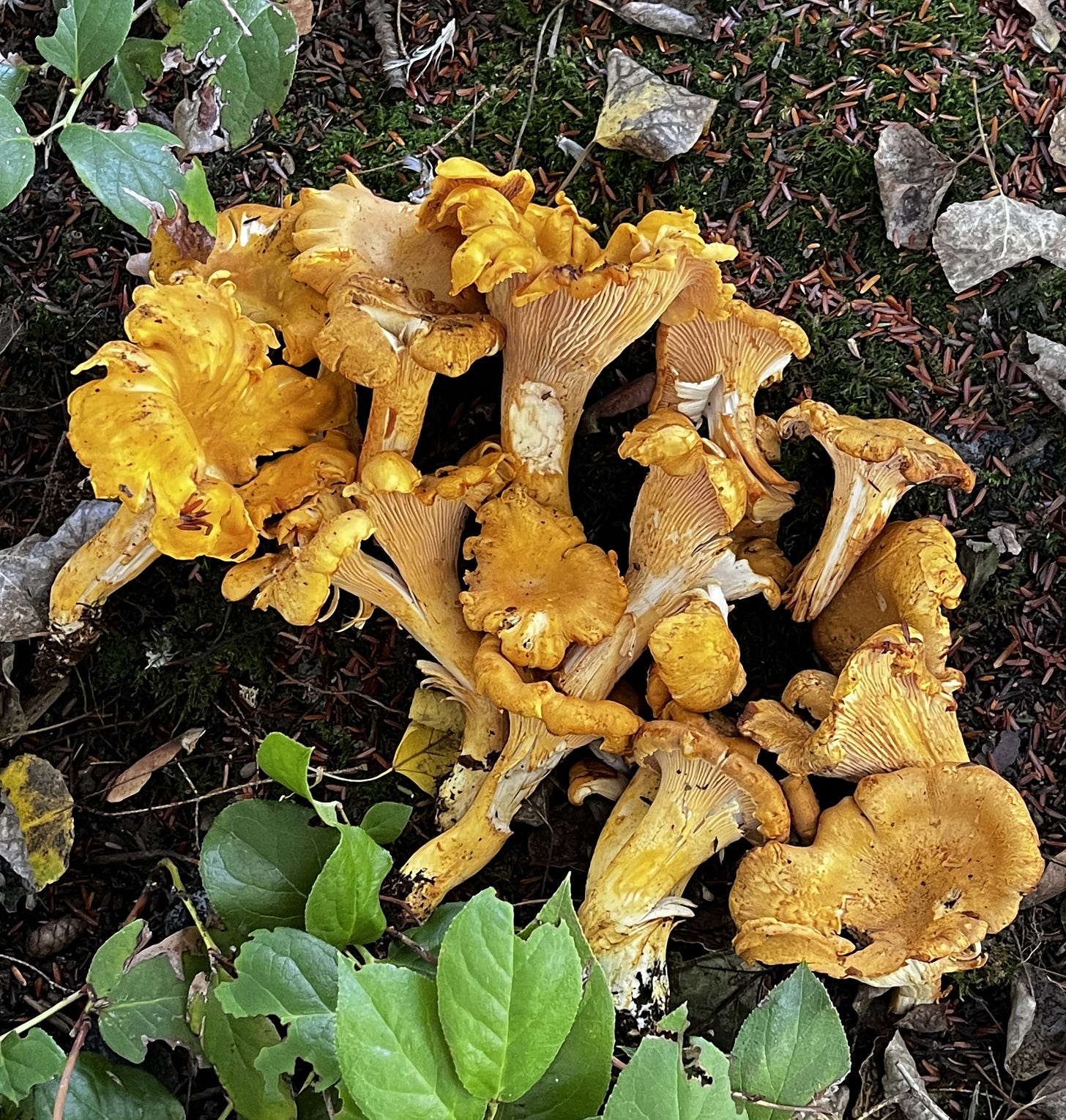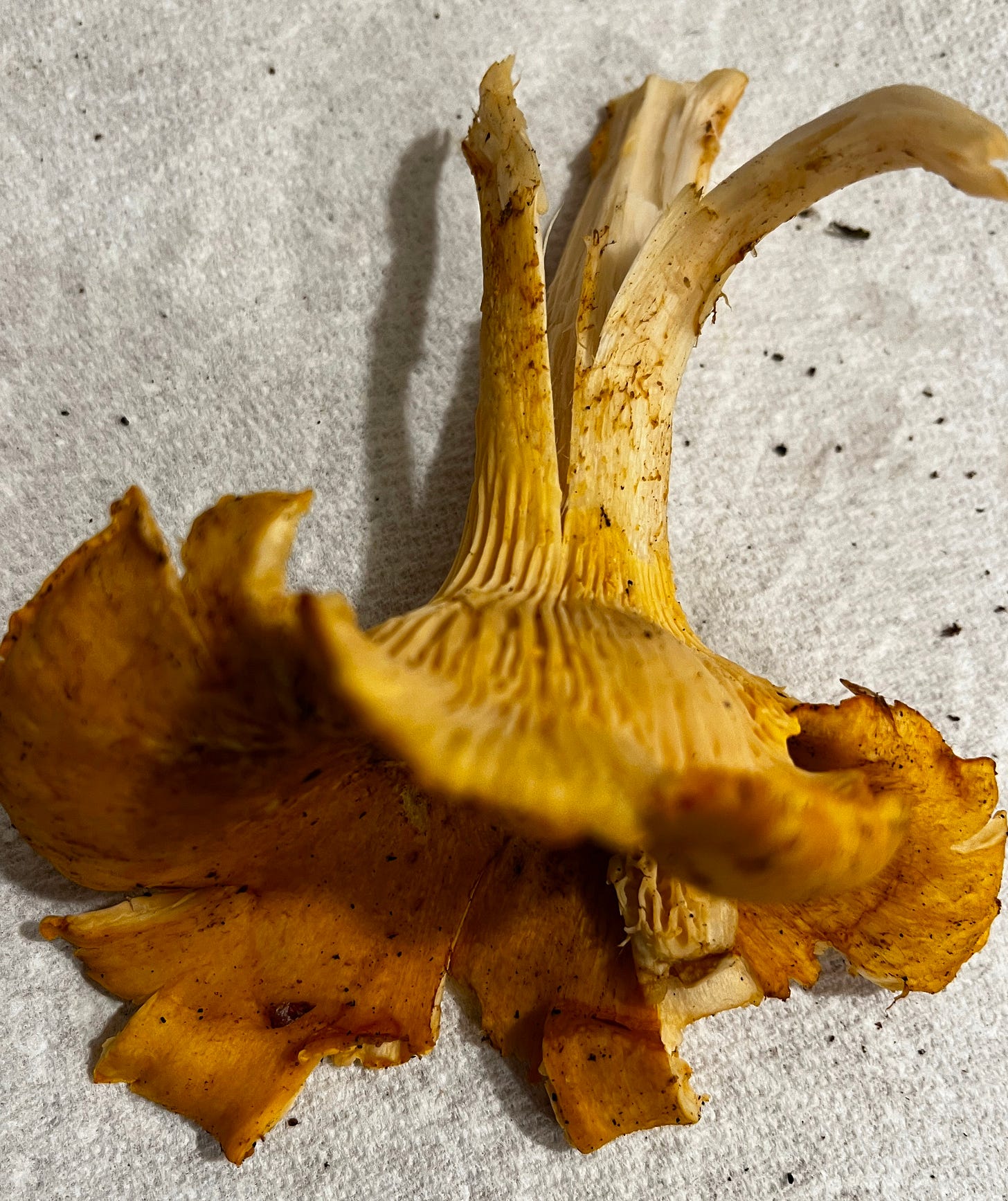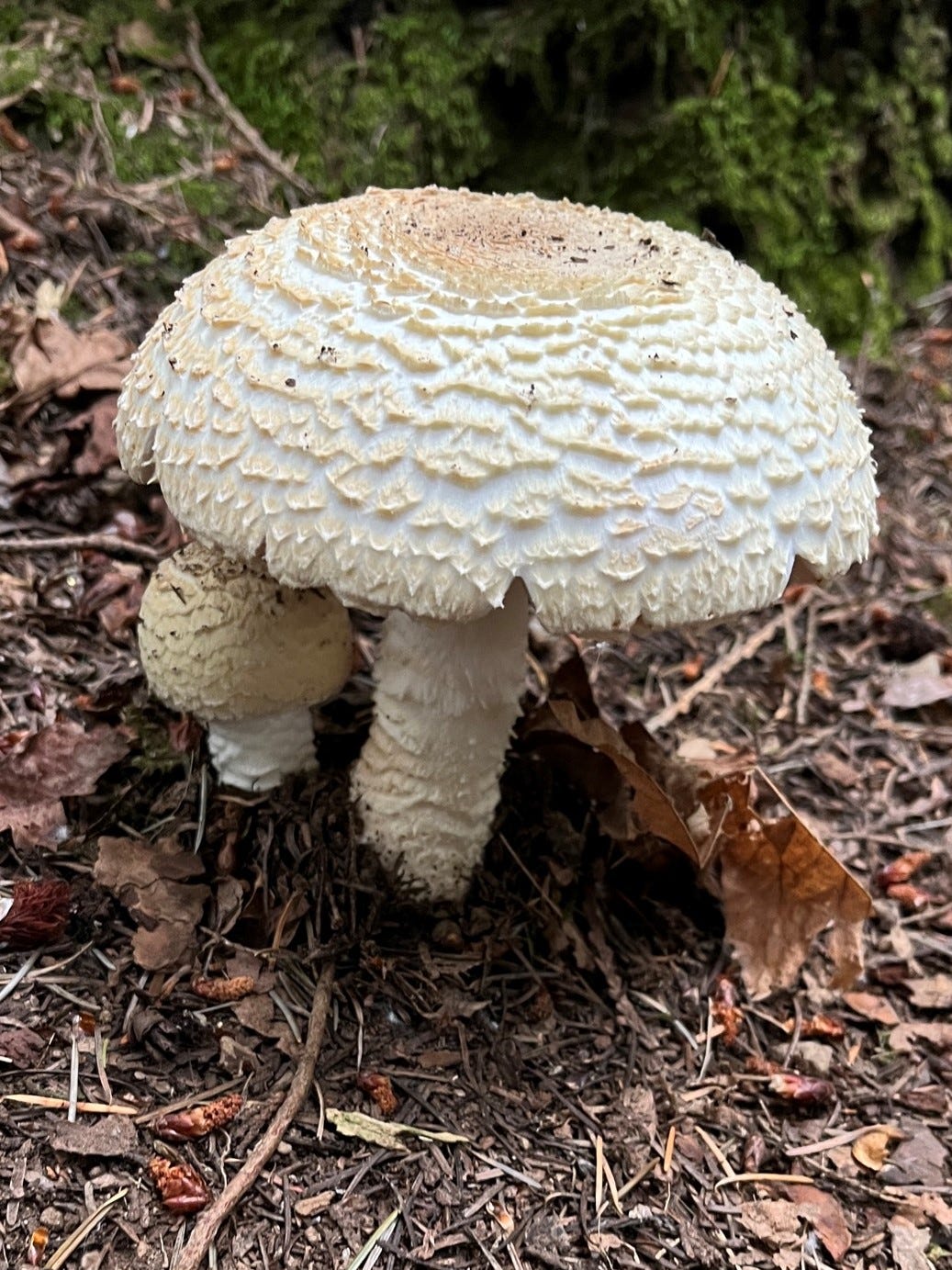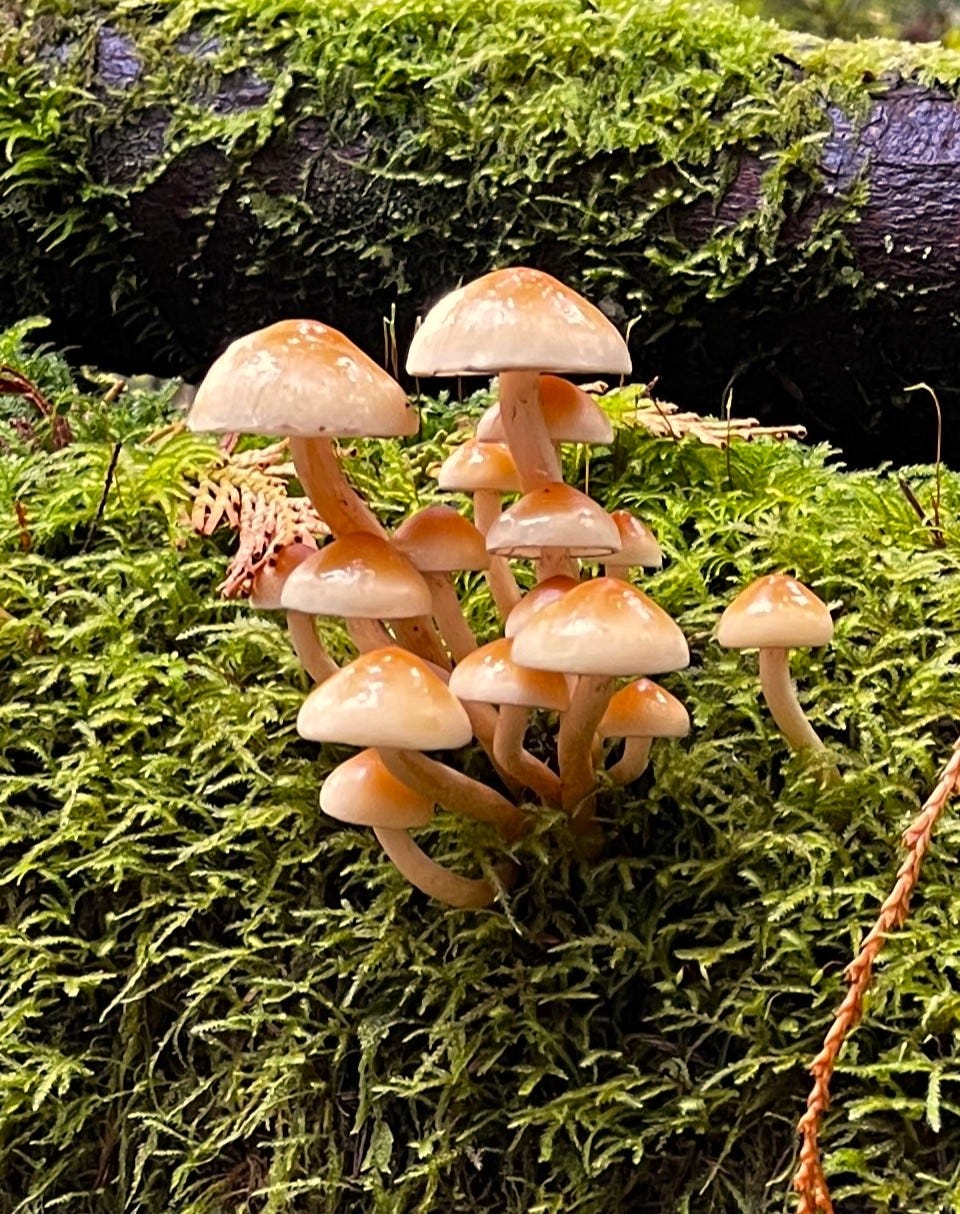Pacific Golden Chantrelles from the woods, just outside of Bellingham, WA
Late summer and early fall rains stir certain mushrooms to begin to build their namesakes and to form their their new bodies that then push upwards through the damp duff and humus soil. Thus they fruit in September through November leading to the best mushroom foraging of the year. This year was/is a big year for both rain and shrooms as they were plentiful and are still coming on. There are too many choice fall mushrooms to name them all but I’ll present some of my favorites that I’ve harvested this year so far along with a few less favorite but interesting fall species.
Choice Edible Mushrooms
Chanterelles and relatives
An all time favorite mushroom in the Pacific Northwest is the Pacific Golden Chanterelle (Chanterelles formosus), pictured in the lead photo. There are several variants in the same family and genus that are delicious as well and I’ll note one of these below. “Chanties” as some call them are special and are considered by most mycologists as among the best in our area, and that says lot as there are many other very choice mushrooms. Chanterelles are found in close association with various conifer trees such as Douglas-Fir, Hemlock, and pines as they share a “mycorrhizal” relationship, meaning the trees’ roots intermingle with the mushroom’s mycelium (root-like structures) through which they share nutrients.
How does one know that what looks like a chanterelle or any other mushroom, is really the tasty tidbit that it looks like? This is a question that all mushroomers must constantly ask themselves. Some are rather easy to identify while others are less so. Many have a few telltale signs that can tip you off as to its true character. I will just mention some of these identification tests for each of the fungi presented here. For example, here as you can see in the lead photo that the top half of the stem up to the lip of cap part is striated with ridges or folds running up. You will notice some of the stems in the photo are stripped up with a bit of a curl as it comes off the stem. If this is a true chantrelle, you can strip these stems just like pulling strips off a piece of string cheese leaving a white meaty body underneath.
Pacific Golden Chanterelle with its stem peeled up like cheese stick.
Caveat: The Identifcation tips I present are but examples of the processes that foragers go through to safely ID a given wild mushroom. These examples however are insufficient to ensure that you can safely eat any given mushroom. Always check with a knowledgeable forager before eating wild musrooms and save yourself from a bad GI upset, failed organs, and/or death. It is safest also to always cook wild mushrooms before eating them as the heat breaks down many, but not all of the toxic chemicals that cause illness.
A close cousin of the Pacific Golden Chanterelle is one called Yellow Foot or Funnel Chanterelle. Until recently, this little beauty was classified in the genus of Canterelles, but as separate species. DNA studies have now moved it to a separate genus but the fact remains that these are still related and are just as tasty as the golden pacific although there is one small but important difference. These are quite small and one must pick a large number of them to enjoy their delights. As seen in the photo below on the left, when young they are about the size of a pinna (leaf) on a frond of a sword fern, about an inch or two. The ones on the right are a bit more mature and about three inches tall. Note that they have striations and indents on their stems making them look more like their cousins, the chanterelles. These indents are cues that this is indeed a Yellow Foot. Although they are quite small, fortunately they grow in large patches so you can often gather a nice bunch at a time. I recently took a handfull of these diminutive fungi, cooked them in a bowl of raman soup and they were great.
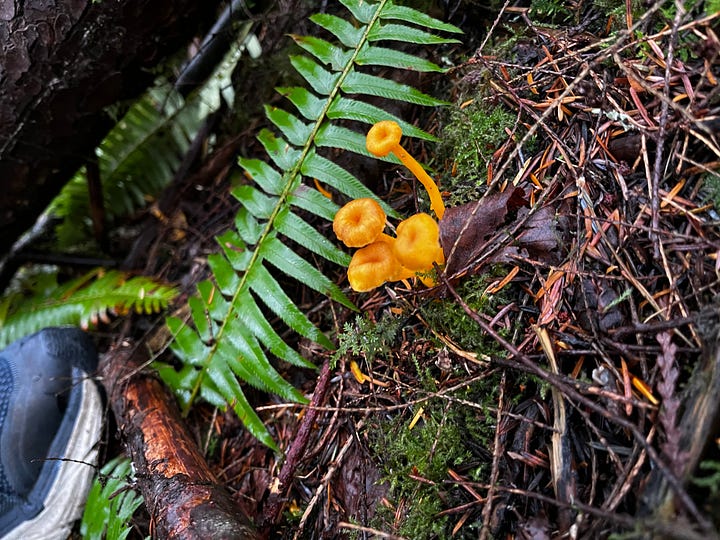

Yellow Foot at different stages. Tiny relatives of Chanterelles but still tasty.
The Prince
The Prince (Agaricus agustus) is one of the real “choise” mushrooms in the PNW along with Chantrelles above and Shaggy Parasol below. The Princes’s lineage is familar to all who have bought mushrooms at the store as it is a close relative to what is always available in the produce sections: the Button, the Crimeni, and the Portabello. These last three are all the same species and therefore are essentially the same mushroom picked at different stages of maturity. These and the Prince are in the same genus of Agaricus. Eating a raw nibble on the Prince tastes very much like eating a button mushroom, only when cooked the Prince tastes even better!
The Prince (Agarica augusta)
The other day as I was leaving one of our large city parks that is essentially a conifer forest, something caught my eye in the proximity of a large Douglas-fir tree. I litterally slammed on the breaks, got out and began examining the two specimens there. Could this really be the Prince? I checked my iNaturalist app and it agreed that it was probably The Prince. I had previously only found them in July but some sources says that they fruit twice a year. That’s fine by me.
This could be a great find for me. I took it home and did a spore print which turned out dark brown as is characteristic of the Prince. Also, It is known for its aroma which to those with a good sense of smell is like almond extract. I could not get that smell at first but I figured that was my fault. After storing them in a paper bag over night in the fridge, I sniffed it again and wow! There it was like someone had just opened a bottle of almond extract under my nose. Bingo. Now I can eat them and have two places to look for them next year.
Shaggy Parasol
Another tasty fall fruiting fungus that is abundant and popular in the PNW is the Shaggy Parasol (Chlorophylum oliveri ) shown below. As is apparent, they are indeed shaggy and when mature like the one on the left below, their cap along with a long stem (stipe) looks like a parasol. They are very tasty and are considered choice by foragers. Shaggy Parasols are found in proximity to conifers such as Hemlock, Douglas-Fir. I am going to use the ones I found shown here in a musrooms soup along with others noted here. It will be a mega choice mushroom soup.
One test to be sure that you have the Shaggy parasol is that they are sort of color coded such that the cap and the stem will turn orangish when bruised or scratched like the stem on the young one in the photo at the right.


Shaggy Parasols (Chlorophylum oliveri)
Wood Blewit
The wood blewit (Collybia, nuda) is an attractive mushroom in that it’s cap and it’s gills under the cap are purplish in color, particularly when they are younger. Contrary to some fungi, when the nights start getting chilly, the Blewit comes out in full color.

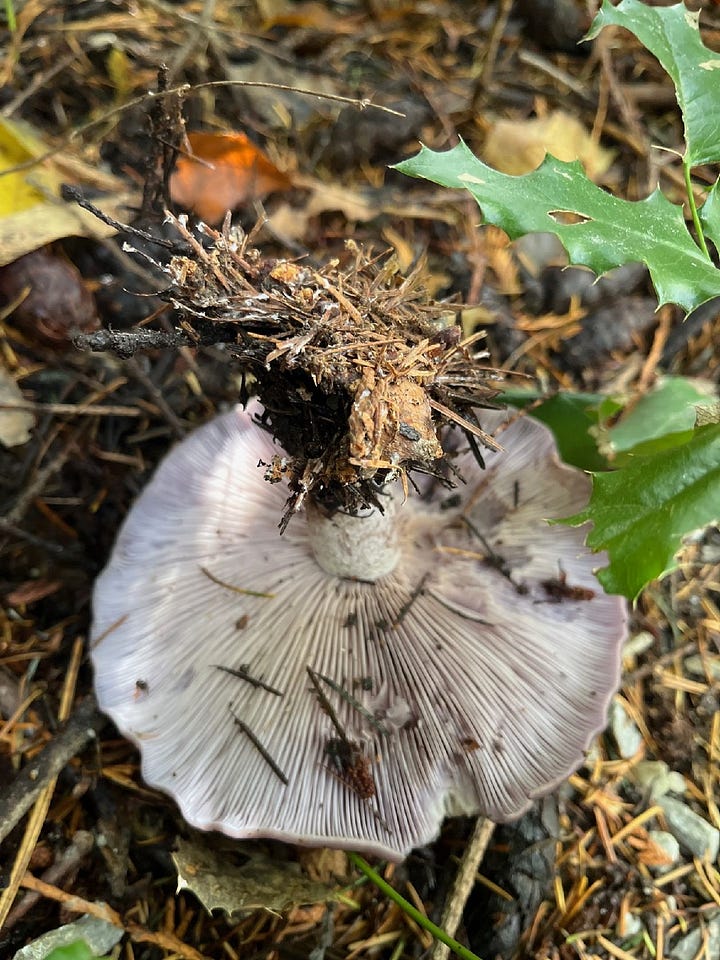
Wood Blewit (Collybia, nuda), cap on the left and gills on the right
In addition to their coloration, Blewits have several several properties to help identify them as different from other look-alikes. One ID charaterstic is that they have a rather distictive odor that is said to smell fruity or as one expert said: “like a can of frozen orange juice.“ Identifying the Blewit is not as easy as it might seem since there are several others that are also purplish. Another test for determining whether one’s purple mushroom is a Blewit is from its spore color. Mushrooms’ reproductive microscopic spores are typically produced in the gills under its cap and when mature the spores are dropped to be dispersed in the woodlands. The color of the Blewit spores are typically a light pinkish with some tan-like shades. Most of it’s look-alikes have brown spores.
Below is a spore print I took of a Blewit by removing the stem and placing the cap, gill side down on a piece of black paper. After severals hours the spores fell out of the gills leaving a color print. On this print the spores turned out to have a white to pinkish and tan color. The photo shown here came out with a bit of an off-white and tan color but is close enough to suggest Blewit.

Spore print of the Blewit
The Blewits are quite edible although not as distinctively flavorful as the previous groups. They have a fine texture with mild mushroomy taste. They are said to taste much like button mushrooms you might buy in a market. However, they should never be eaten raw as they can cause intense gastro-intestinal distress with vomiting and diarrhea. Cooking it well neutralizes the responsibile chemical. This caution holds for most all mushrooms found anywhere but the grocery store. Those have been well vetted for toxcity and are safely eaten raw or cooked.
Other Edibles
There are a few other fall edibles in our environs although they are not really choice like the previous ones. That is they are considered edible such that you can eat them without adverse effects and some people like them although they are mild tasting. However, if you cook them with butter and garlic, they are not bad. Of course shoe leather too would be edible with garlic and butter.
Russula
The Genus of Russula also referred to as “Brittlegills,” has a large number of species under it. They are indeed brittle and as a means of indentification, you can throw one at a tree and if it is a brittlegill, it will shatter like glass. But then you’ve lost the shroom.
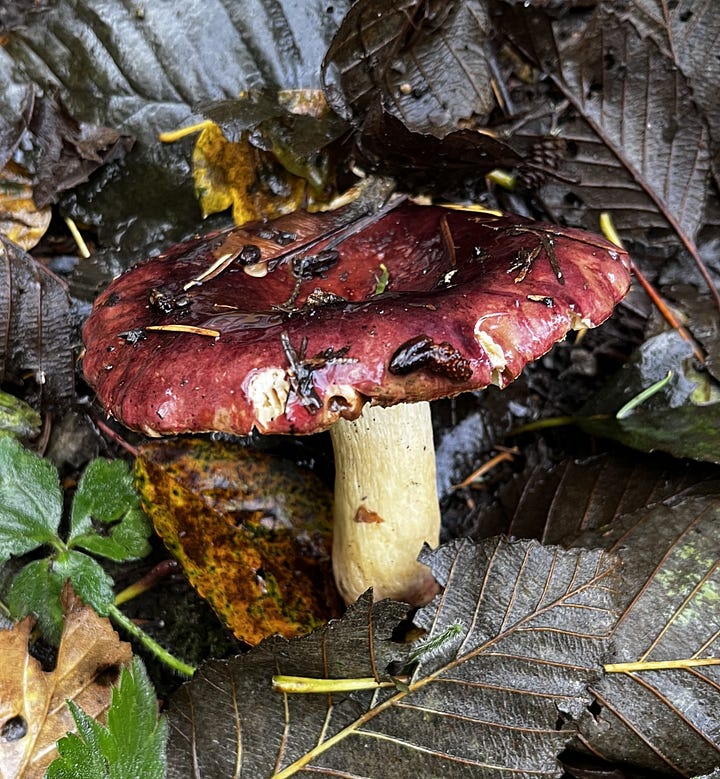
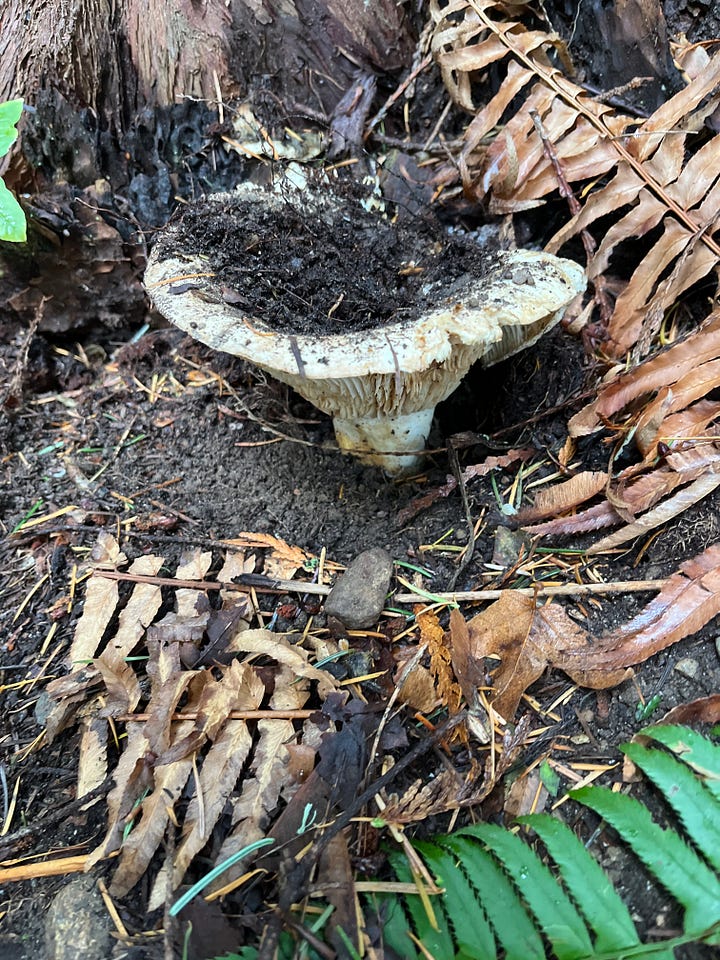
One species that is especially common and sought after around here is the Shrimp or shellfish scented Russula (xerampelina) shown on the left above. Before and while being cooked, it has a distinctive scent. It is smells like you just walked into a fish market. Although they have a general mushroom flavor, they are not particulary tasty. They have great texure and are often used in mushroom soups.
Another species of Russula found around here is the Short Stemmed Russula (Russula brevipes). These have a large cap with a bit of a funnel shape that collects lots of forest dirt as it pokes up from below the ground and it has a short stem. These too are edible, though not really tasty. I took a nibble of one recently and it tasted like I was chewing a pepper corn. I have read that some people use thes\e as the base for humus and it is reportedly very good.
This same mushroom however can become really delicious when it is infected with another fungus (Hypomyces lactifluorum) which changes it dramatically, including its genetic profile. This infection turns the mushroom red/orange all over and transforms the rather bland mushroom into a delicious choice one that is expensive and highly sought after. After being infected, this Russula is no longer a Russula according to genetic studies. Click the link below to see an example.
Nice fresh specimens that are completely white on the interior are best. They can tend to have brown spots that should be trimmed off though. Plain preparation is a good choice. Clean young specimens will often have a seafood odor when you cook them that is a natural with lobster, crab, or other seafood. When sautéing or pan frying, it creates a lobster colored orange juice in the pan that can make your dish more festive and lobster-like. The flavor and aroma characteristics are ephemeral so be sure not overcook or the aroma will be lost. Tempura frying is very pleasant as well.
Red Cracking Bolete
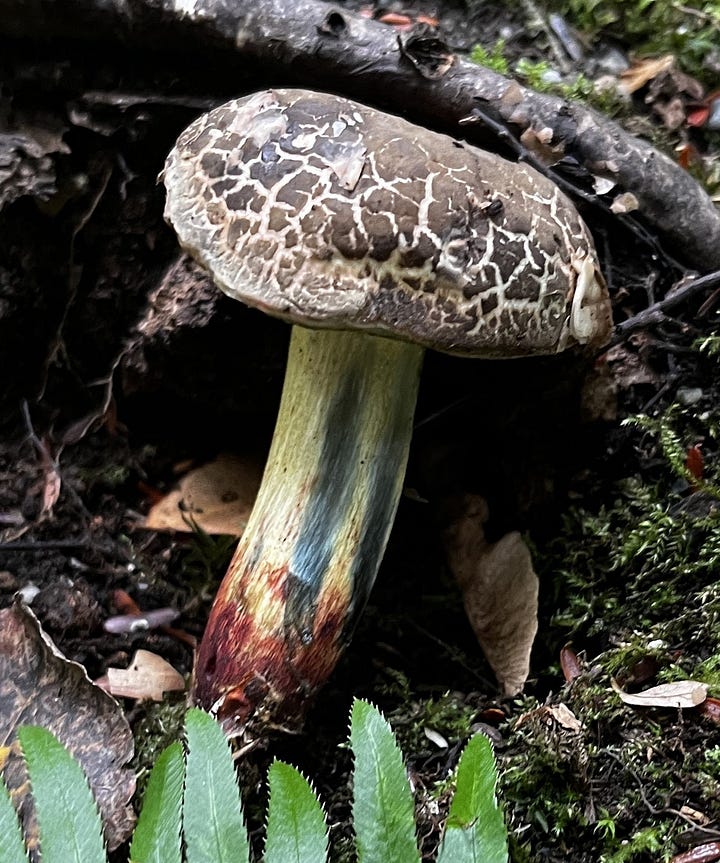
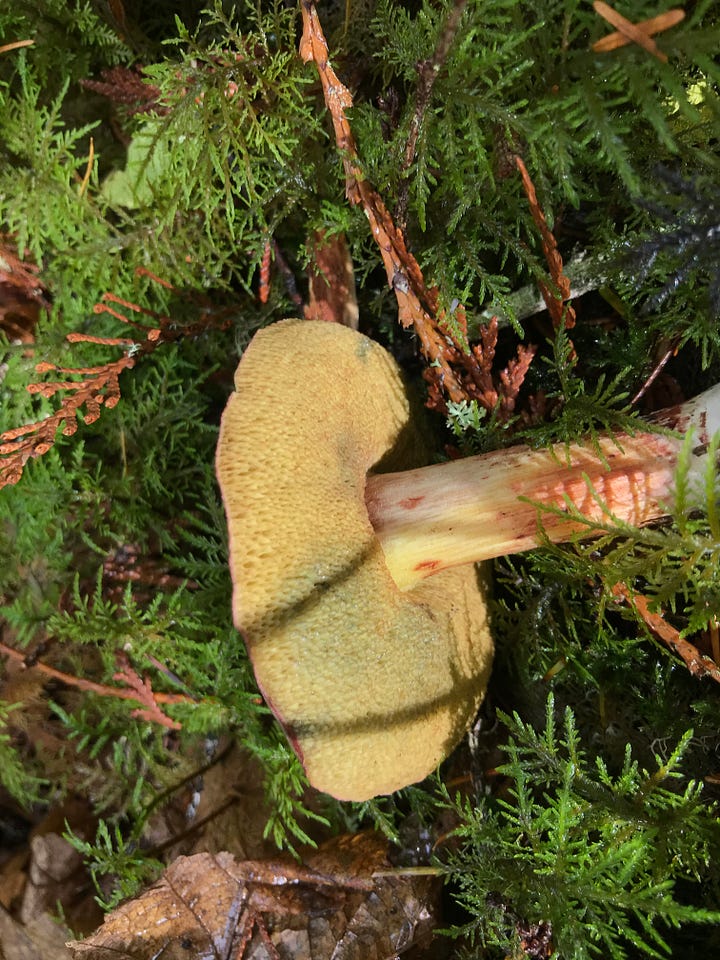
Red Cracking Bolete (Xerocommelus defractus)
This is another of edible but nothing to rave about mushrooms. However it is interesting and can be attractive as well. As you see it has a cracking cap, sometimes with red on the cracks and there is red on the stem. As with the Shaggy parasol above, this is color coded as well. It you bruise or scratch this one, it will turn blue as on the stem in the left photo.
You will notice that one on the right shows a sponge-like structure under the cap. Rather than gills like the previous mushrooms have under the cap for spore production, the Red Cracking Bolete has a pore surface. It is in the family called Boletaceae and most mushrooms under this family have tubes in which the reproductive spores develop. They are referred to as boletes
Puff balls
The Puffball’s basic feature is that they have a more or less spherical or rounded top with a broad stem. Inside this spherical top is where they develop their spores that are to be distributed in the environment when they are ready to reproduce. When puffballs are young like the ones at the left, they are solid inside and if sliced open, they will look like a sliced marshmallow. At this point they are edible. The author of recent book on mushrooms identification wrote about these that when he is in woods, he will take a slice of the firm white puffball and add it to his sandwich for lunch. (See Daniel Winkler, Fruits of the Forest, 2023 )
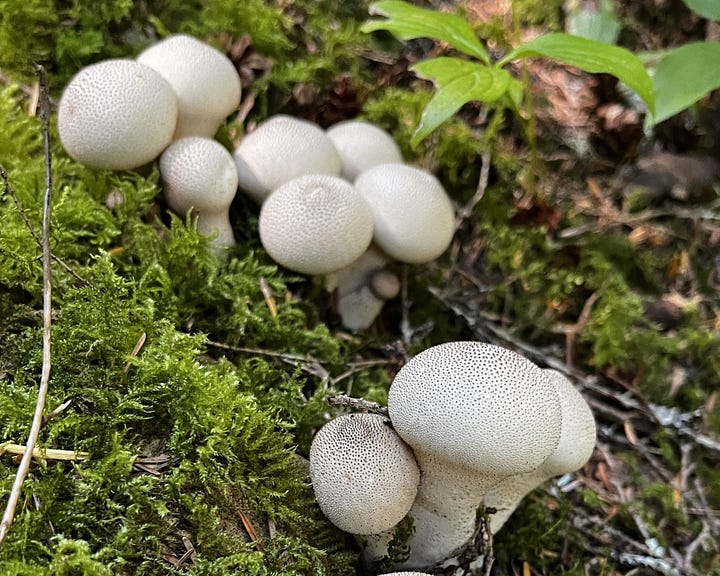
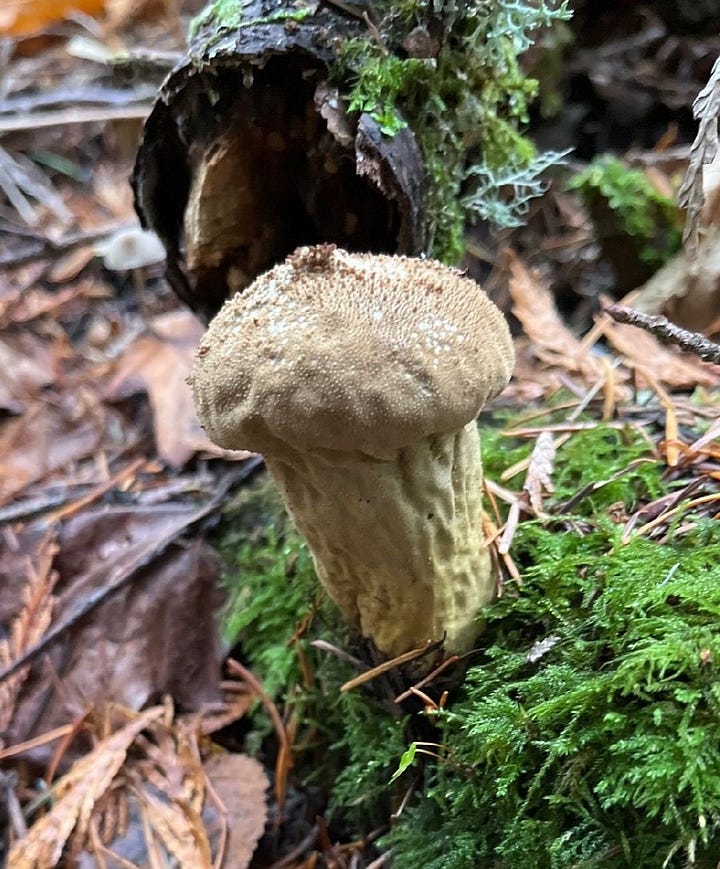
Two of numerous Puffball mushrooms. On the left are gem studded puffballs in their prime and on the right is an older pedestal puffball having already puffed out its spores through the hole in its top.
When the puffball matures a bit more the marshmallow-like stuff inside transforms into reproductive spores. The Puffball then becomes rather fragile and they develop a hole in the top as you see in the one at the right. When anything touches the body it puffs spores out into the air to be distributed around on the forest floor to become future puffballs. A rain drop falling on it or an animal brushing it all suffice to sow the spores for a new generation.
Hypoloma
I’ll wrap this up with with another lovely fungus, commonly growing on logs in the woods around here. It is clearly in the genus of Hypoloma but without closer examination, I am not sure whether if it is of the species capnoides (Conifer tuft) and therefore edible and quite good or if it is of a close cousin in the species faciculare (Sulfur tuft). Since I did not intend to pick this mushroom, I did not examine it closely. Were I serious about it, that would have been critical since the capnoides is edible while fasciculare is poisenous and causes seriously intense GI illness. There are a few clues to differentiate these: The sulfur tuft has green gills and tastes very bitter. UGH.
Hypoloma
The end
There you have a cursury look at some of mushrooms that I have collected these past couple of months. The whole process has been invigorating including the walking and poking around in the woods. It is also fun to identify the mushrooms by rifling through identification books, online web sites and checking all their individual tests to make sure they were edible. I have eaten each of these except the hypholoma this fall and since I am here to tell about it and without GI distress, I must have gotten the testing right.
As I noted at the beginning, fall rains bring forth fall mushrooms and we had plenty of rain this year. And it is still raining as I write this. Consequently we have had a huge mushroom foraging season so far. The coming rains will likely prolong the glorious crop as long as the temps don’t get down to freezing. When it gets cold most of them will keep their heads down until next year. Maybe I’ll do a repeat post for fall 2025 to compare it with this year’s crop.
Stay tuned for more fun with Mother Nature. She and I love the greenery and fresh air and water that she provides. Next up, it is Salmon Spawning Season where the Salmon return from the saltwater to their native streams to lay their eggs for the next generation. More to come.



